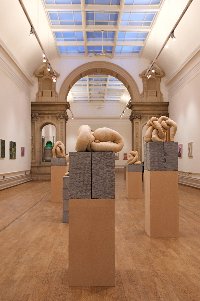Hayward Touring takes work by hot contemporary artists into the UK’s cultural ‘cold spots’. Roger Malbert explains what goes on behind the scenes

Hayward Touring is the largest organisation touring contemporary art in Britain. We are a part of the Hayward Gallery at the Southbank Centre, we receive funding from Arts Council England (ACE) and also tour the Arts Council Collection. A dedicated team of curators organise exhibitions which tour to diverse venues across the UK and Ireland. We share technical and administrative resources with the Hayward and have our own transport with experienced driver-technicians who work with staff in local galleries to help install our shows
Hayward Touring works with every kind of visual arts venue in the public sector: contemporary art galleries, municipal museums, university galleries, arts centres, libraries, schools and colleges, and occasionally artist-run spaces. In 2009-10 Hayward Touring exhibitions were seen in 70 venues by 482,828 visitors across the UK. Exhibitions range in scale from small-scale, low-security shows of prints and photography that may tour for four or five years, to the British Art Show (BAS) – a large-scale, multi-site survey exhibition.
Our primary objective is to present innovative, high quality exhibitions of contemporary art to a wide public. Touring exhibitions provide a model of economic partnership that can maximise the cost-effectiveness of ambitious exhibitions.
We aim to enhance the potential for the professional development of local curators by sharing ideas, expertise and resources. We also try to develop and promote new curatorial models, including artist-centred projects – exploiting artists’ exceptional communication skills to reach new audiences across a wide demographic. Hayward Touring organises the Hayward Curatorial Open, a platform for innovative curatorship in the UK.
Hayward Touring aims for the maximum reach geographically, across a wide range of venues and a broad social, economic, cultural and generational demographic. BAS is our highest profile exhibition; it travels to four different cities across Britain and is usually hosted by a consortium of partner organisations in each city, as there are few venues large enough to take the whole show (BALTIC and the Hayward being exceptions). This has become a key feature of the exhibition. The local consortia typically include a wide range of venues – municipal museums, contemporary art galleries, university galleries and sometimes artist-run or temporary spaces. Hayward Touring works closely with them, and they collaborate together in presenting and publicising the exhibition.
BAS has been touring since 1979 and has established a reputation as the biggest and most ambitious exhibition of British contemporary art in the UK. It attracts high visitor figures and is seen as a catalyst for raising the profile of visual arts organisations and developing new audiences: research in Plymouth, for example, for BAS 7 found that 60% of visitors surveyed were first-time visitors to the venue in question. In its seventh incarnation in 2010-11, BAS featured work by 39 artists and attracted a record total of 425,000 visits during its 15-month run across a total of 12 venues in Nottingham, London, Glasgow and Plymouth. Recently released figures attribute a 24% increase in visitors at Gallery of Modern Art, Glasgow, mainly to the success of BAS 7.
The exhibition’s record means that it is in demand and cities generally approach the Hayward requesting to participate. The fee for each city (a contribution to organisational costs) is raised locally from a variety of sources, including regional ACE offices. There are a number of criteria for selecting the cities: past history (we look for new situations); the level of commitment and collaborative spirit in a new consortium; Arts Council advice on strategic priorities and potential for development (so-called ‘cold spots’ where there is poor provision for the visual arts); local funding prospects; and the geographical spread of a four city tour.
BAS is hugely collaborative on many levels. Colleagues in each gallery in the four cities on the tour participate in the process of selecting the guest curators (two individuals with proven knowledge of contemporary art, good powers of communication and a disposition to work collaboratively), share decisions about the marketing (design and strategies), plans for the presentation of the show locally and the organisation of ancillary events.
For BAS 7 the venues hosted an extensive public programme of 53 artist-led events, including a 24-hour screening of Christian Marclay’s The Clock in each of the four cities. The context in each city is different, and the show takes a different form as it travels. For example, the supporting educational programme in Plymouth was very strong on social engagement. A team of 70 young artists and students were trained to act as live guides in the galleries, speaking to visitors and hearing their responses. In London a local project brought 27 young people from Efford, a deprived area on the outskirts of the city, by coach to see the exhibition at the Hayward (many of them had never visited London before). They subsequently made a film involving interviews with local people about the work in the exhibition. And in Nottingham, local artists’ groups used the exhibition as an opportunity to organise a programme of exhibitions and live events for a programme called Side Show.
Roger Malbert is Head of Hayward Touring, Southbank Centre
E roger.malbert@southbankcentre.co.uk
T 020 7921 0860



